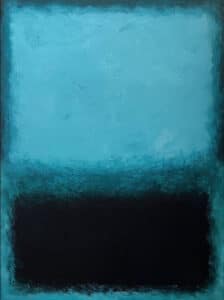Mark Rothko: An Odyssey of Color and Emotion
Mark Rothko, celebrated as a master of color-field painting, possessed an extraordinary ability to convey deep, complex emotions through his art. His paintings, such as “No. 61 (Rust and Blue),” stand as testaments to the raw, unfiltered power of color in evoking emotional responses. Rothko’s large, immersive canvases do not merely display colors; they envelop viewers in a nearly spiritual experience, creating an environment that transcends the traditional boundaries of art. The abstract blocks of color in his paintings are far more than aesthetic elements; they are conduits of emotional expression. As an art enthusiast, I find myself deeply drawn to Rothko’s work, as it challenges me to confront my own emotions and delve into the nuanced layers of feeling that color can communicate.
Born in 1903 in Dvinsk, Russia (now Daugavpils, Latvia), Rothko emigrated to the United States with his family in 1913. His early years in art were marked by experimentation with various styles and forms, including surrealism and figurative painting. However, it was in the late 1940s that Rothko began to develop the style that he would become famous for: large, luminous fields of color, devoid of figurative elements, focusing purely on emotional and spiritual resonance.
Rothko’s approach to art was deeply philosophical. He believed that art was a powerful means of emotional and spiritual communication. He once said, “I’m not an abstractionist…I’m not interested in the relationship of color or form or anything else. I’m interested only in expressing basic human emotions: tragedy, ecstasy, doom, and so on.” This philosophy is evident in works like “No. 61 (Rust and Blue),” where the juxtaposition of colors and the vastness of the canvas create a profound emotional impact.
In the world of abstract expressionism, Rothko found a platform that allowed him to explore the depths of human emotion. His paintings are characterized by soft, blurred edges that make the colors seem to float and merge into each other, creating a sense of infinity and immensity. This effect is heightened by the scale of his canvases, which are often large enough to fill the viewer’s entire field of vision, creating an enveloping, almost overwhelming experience.
Rothko’s art invites viewers to engage on a deeply personal level. The lack of form, the absence of figures or landscapes, means that each viewer’s experience of a Rothko painting is unique, influenced by their own emotions and experiences. This is what makes his work timeless and universally appealing. The colors and their interactions on the canvas become a mirror, reflecting the viewer’s inner state back to them.
Throughout his career, Rothko continued to evolve his use of color and form. His early works feature brighter, more vibrant colors, while his later pieces, often referred to as his “dark paintings,” feature deeper, more somber tones, reflecting perhaps the artist’s own inner turmoil. These later paintings are particularly powerful, as they convey a sense of profound introspection and melancholy.
Rothko’s influence on the art world extends beyond his paintings. His approach to art as a medium for emotional and spiritual exploration has inspired countless artists. He challenged the conventional notions of what art could be and what it could do, pushing the boundaries of abstraction and opening up new possibilities for emotional expression in visual art.
The significance of Rothko’s work lies not just in the visual impact of his paintings, but in their ability to connect with viewers on a deep, emotional level. His paintings are not just to be seen; they are to be experienced. They invite contemplation and introspection, offering each viewer a unique emotional journey.
In conclusion, Mark Rothko’s contribution to the world of art is immeasurable. His mastery of color and form, his philosophical approach to art, and his ability to evoke deep emotional responses have secured his place as one of the most influential artists of the 20th century. His works, such as “No. 61 (Rust and Blue),” continue to captivate audiences, drawing them into a world where color and emotion intertwine. Rothko’s legacy is a reminder of the vast, uncharted territory that abstraction opens for both artists and viewers, encouraging a deeper exploration of the human experience through the medium of art. His work encourages us to explore the depths of our own emotions, inviting us to engage with the world of abstract expressionism on a deeply personal level. Through his exploration of color and form, Rothko redefined

